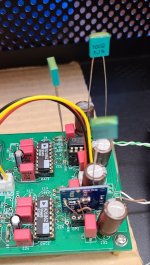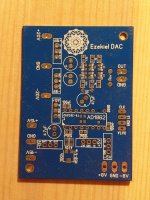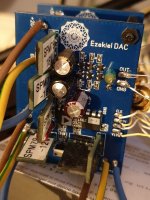To keep you busy, here is another IV idea, fresh from the press.
https://www.diyaudio.com/community/threads/zen-i-v-converter.173291/post-6927415
Have not built, but pretty sure it works as intended. 😉
Patrick
https://www.diyaudio.com/community/threads/zen-i-v-converter.173291/post-6927415
Have not built, but pretty sure it works as intended. 😉
Patrick
Paddy,
That looks very nice.
I just tried the AD797 with Hidy's recommendation of putting a cap across pins 2 and 3. I used a 1000pF cap and it does sound nice. I will try the same thing the the LM6171 and ADA4627 I have. May even try doubling the cap to get the recommended 2000pF on the AD797.
That looks very nice.
I just tried the AD797 with Hidy's recommendation of putting a cap across pins 2 and 3. I used a 1000pF cap and it does sound nice. I will try the same thing the the LM6171 and ADA4627 I have. May even try doubling the cap to get the recommended 2000pF on the AD797.
Thanks Patrick..
Nice work Paddy. I must get mine soldered up. I kind of lost my smd mojo but I must push on.
Currently on 6171 was I may try the 1000pf thing too.!
Nice work Paddy. I must get mine soldered up. I kind of lost my smd mojo but I must push on.
Currently on 6171 was I may try the 1000pf thing too.!
Plug and play.
Well, it wasn't until you said that... I stole the kit I set aside for my son and built it up without the onboard SMD Civ in order to use the Xen IV.
I like to test op amps by putting different ones in and listening to mono music, so P&P would be great. Hmm. C31 and C36 don't have to be onboard, do they?
Attachments
I seem I spot a couple of rhopoint... how do you like the sound? I have to look for a couple of those I/V boards...Well, it wasn't until you said that... I stole the kit I set aside for my son and built it up without the onboard SMD Civ in order to use the Xen IV.
I like to test op amps by putting different ones in and listening to mono music, so P&P would be great. Hmm. C31 and C36 don't have to be onboard, do they?
When everything else is good they make a small difference over the Vishay metal films I had used. But the Vishays cost 26 times less, so not value for money IMO. I bought some extra MELF resistors as used on the Xen board and have soldered some leads to them to try out someday against the Rhopoint (actually Prime Technology). They'll probably be fine.
Were I to start this again I would spend first on audio capacitors, then power, then op amps, then digital side. Your mileage may vary, of course.
Were I to start this again I would spend first on audio capacitors, then power, then op amps, then digital side. Your mileage may vary, of course.
Hi guys!
I'm starting to plan this DAC assembling.
I'm curious if there is any way to add a controller plate with remote control for switching i2s inputs and volume control.
I'm starting to plan this DAC assembling.
I'm curious if there is any way to add a controller plate with remote control for switching i2s inputs and volume control.
I bought some extra MELF resistors as used on the Xen board and have soldered some leads to them to try out someday
You can get leaded versions.
https://www.vishay.com/docs/28766/mbxsma.pdf
Patrick
Funny - guess I shouldn't have wasted my time soldering, since I was already using those before the Prime Techs
Just a crazy example: https://create.arduino.cc/projecthub/keith-walker/a-remote-controlled-stereo-volume-control-71968d@Vavilen I can't think of anything elegant 🙁
+ i2s source selection control using the same arduino
Nice article. I built something similar (and for the same reason) and used it with both a motor-driven potentiometer and a muses control. The muses bit-banging interface is a little complex to drive from arduino but not too bad.
I think the Academy Audio MCL might get you much of the way to your goal: https://www.academyaudio.com/mcl
Muses volume control, remote, and a connector that drives their analog input switch board. If you can figure out what signals that connector sends you can just build the i2s switch to match. Lenny at Academy is very helpful, drop them an email.
I think the Academy Audio MCL might get you much of the way to your goal: https://www.academyaudio.com/mcl
Muses volume control, remote, and a connector that drives their analog input switch board. If you can figure out what signals that connector sends you can just build the i2s switch to match. Lenny at Academy is very helpful, drop them an email.
I have no idea for the I2S switch but I assume it could be made with high quality contact relays and a manual switch while the volume pot could be another solution like the Good Meldano kit after the I/V stage : https://www.diyaudio.com/community/threads/muses-volume.322983/post-5440394
Super cool project!
Back in 2019 I made my own AD1862 dac. I think there's a thread here on the forum. I went with a bit of a different approach, with two mono boards stacked on top of each other. And I use the JLSounds USB board to avoid the timing issues. I also went for a lot more surface mounted components, and a pure smd zero feedback discreet I/V stage. I have been using this dac in my main setup every day since. The AD1862 is absolutely amazing!
One question tho. It seems like most people don't apply the trim resistor. Why is this? In my experience it is absolutely crucial. As per Jocko Homo on diyhifi you trim it by feeding the dac with a -60dB sine signal and just trim it until the scope shows no noise. Or you can even do it by ear. Fire your amp up on full volume, play some music, and just trim until the noise goes away. The noise may be inaudible at normal listening levels, but it's certainly there.
I attached some pics of my build. It looks messy as heck, but it sounds wonderful.
Back in 2019 I made my own AD1862 dac. I think there's a thread here on the forum. I went with a bit of a different approach, with two mono boards stacked on top of each other. And I use the JLSounds USB board to avoid the timing issues. I also went for a lot more surface mounted components, and a pure smd zero feedback discreet I/V stage. I have been using this dac in my main setup every day since. The AD1862 is absolutely amazing!
One question tho. It seems like most people don't apply the trim resistor. Why is this? In my experience it is absolutely crucial. As per Jocko Homo on diyhifi you trim it by feeding the dac with a -60dB sine signal and just trim it until the scope shows no noise. Or you can even do it by ear. Fire your amp up on full volume, play some music, and just trim until the noise goes away. The noise may be inaudible at normal listening levels, but it's certainly there.
I attached some pics of my build. It looks messy as heck, but it sounds wonderful.
Attachments
@Vavilen If I assume you can (or someone do) program arduino or some cheap rpi (like RP2040) then the potential is limitless and you can do everything including remote, display, switches 😎
Switches can be done simple using signal relays or take an inspiration from this schematic: #2909
... the highest quality volume control is from relays ... or use motorized potentiometer ... avoid single chip digital potentiometers
Switches can be done simple using signal relays or take an inspiration from this schematic: #2909
... the highest quality volume control is from relays ... or use motorized potentiometer ... avoid single chip digital potentiometers
Painkiller... glad to see you there . I still enjoy your through holes 2 boards pcb (I'm the guy who sent you 2 Rhopoints 516G resistors some years ago).
Thanks! I remember now! I really appreciate that. Those Rhopoint resistors are really great. Did you have a chance to complete the dac and do some listening tests and maybe compare to other dacs?Painkiller... glad to see you there . I still enjoy your through holes 2 boards pcb (I'm the guy who sent you 2 Rhopoints 516G resistors some years ago).
yes very lately after we talked. I made first the error because the marking with the two first bjt despite you advertised me, then left it few months after some problems, then completed it later. Sounds more than good, different from my reference but hard to compare as my ref diy dac has a complex digital front end and clock and had 3 years of work, on passive parts and multiples supplies ! Stock, although yours sounded better than my stock ref tda1541A S1. I see you also use R-core traffos as I did and it is one of the little trick that sounds good with this dac chip... I surmise yours on the photo are old Selectronic with the screen wirered to the main ?
Thanks again for the two boards you sent me back then. If you want to try Miro's for the curiosity I can send you some boards I have left.
here people have fun with I/V stage and also discrete with EUVL member gift, and collaborative: ideas, parts revirws, pcb adaptators (Vunce member), different tube stages (Woodturner fran member), sorting out parts for the discrete (Ripster), and Picasso drawing pcb work of Miro the author... cool thread...crazy guys in a park balls 🙂
Thanks again for the two boards you sent me back then. If you want to try Miro's for the curiosity I can send you some boards I have left.
here people have fun with I/V stage and also discrete with EUVL member gift, and collaborative: ideas, parts revirws, pcb adaptators (Vunce member), different tube stages (Woodturner fran member), sorting out parts for the discrete (Ripster), and Picasso drawing pcb work of Miro the author... cool thread...crazy guys in a park balls 🙂
Last edited:
- Home
- Source & Line
- Digital Line Level
- DAC AD1862: Almost THT, I2S input, NOS, R-2R




